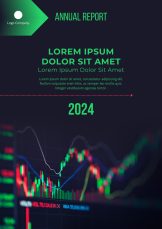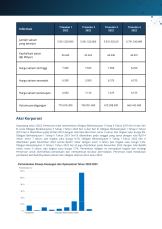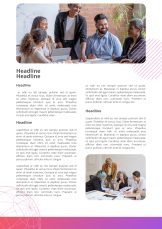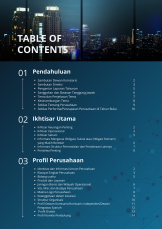
In the modern business world, an annual report is one of the most strategic communication tools companies use to present their performance over the past year. This report is not merely an administrative obligation but a reflection of the company’s transparency and accountability to stakeholders, including investors, business partners, regulators, and the public. In an increasingly competitive market, the annual report plays a crucial role in building trust, providing an overview of the company’s achievements, and outlining plans and strategies for the future. Therefore, preparing an annual report must be done meticulously, structured, and informatively to deliver significant value.
However, for an annual report to effectively convey its message, its design must be engaging, professional, and easy to understand. Good visualization, through the use of appropriate colors, precise typography, neat layouts, and the integration of elements such as infographics, charts, and illustrations, can transform complex data into something more straightforward and appealing. Aesthetic design not only enhances visual appeal but also helps the audience quickly and clearly grasp the information presented. By combining creative design with the company’s identity, an annual report becomes more than just a collection of numbers—it serves as a branding tool that strengthens the company’s image in the eyes of stakeholders.
The Importance of Annual Reports for Companies
Annual reports are essential documents that summarize a company’s performance over the course of a year. These reports not only present financial data but also provide a comprehensive overview of operations, strategies, and achievements. In the modern business era, annual reports serve as strategic communication tools that foster transparency, credibility, and trust between companies and their stakeholders. Companies that can produce well-prepared annual reports demonstrate their commitment to accountability and provide clear direction for their investors, business partners, and external parties.
In addition to promoting transparency, annual reports act as tools for evaluating a company’s internal performance. By compiling annual reports, companies can assess the effectiveness of their strategies, identify challenges, and develop improved plans for the upcoming year. Furthermore, annual reports represent a company’s professionalism in a competitive business environment. Through accurate data presentation and informative narratives, companies can showcase their strengths and distinguish themselves from competitors in the marketplace.
Providing Comprehensive Information for Stakeholders
One of the primary functions of annual reports is to deliver comprehensive and transparent information to stakeholders. The information contained within these reports includes financial data, company strategies, performance achievements, and challenges faced during the year. For investors, annual reports are a crucial source of information to assess a company’s stability and growth potential. Business partners use these reports to evaluate collaborative prospects, while regulators refer to them to ensure compliance with relevant policies. Thus, annual reports form a vital foundation for decision-making by various stakeholders.
Additionally, the transparency provided by annual reports helps build trust between companies and their stakeholders. These reports go beyond numbers and data by presenting the company’s vision, mission, and commitment to sustainable business practices. Through structured communication, companies can demonstrate their solid performance and readiness to face global challenges. With detailed and easily digestible information, annual reports become effective tools for strengthening stakeholder relationships and building a positive public reputation.
Compliance with Government Regulations
The preparation of annual reports is not just a moral obligation but also a legal requirement governed by various regulations. For public companies, annual reports must be routinely submitted to regulatory bodies such as the Financial Services Authority (OJK) and the Indonesia Stock Exchange (BEI). This obligation ensures that companies conduct their business operations transparently and responsibly. By adhering to these regulations, companies can avoid administrative sanctions that could harm their business performance and reputation.
Moreover, compliance in preparing annual reports reflects a company’s commitment to the principles of Good Corporate Governance (GCG). These regulations apply not only to large corporations or publicly listed entities but also to certain businesses in the financial sector or those with public interest. By preparing annual reports that meet established standards, companies fulfill their legal obligations while showcasing integrity and high professionalism. Ultimately, this compliance becomes a cornerstone of maintaining stakeholder trust and supporting long-term business sustainability.
Why Annual Report Design Must Be Attractive?
An attractive annual report design is not merely about aesthetics but also serves a strategic function in effectively conveying company information. As a document detailing annual performance, the annual report contains complex and in-depth data, including financial statements, achievements, and business strategies. Without a well-thought-out design, the report can appear dull and difficult for readers to comprehend. Therefore, an appealing design plays a vital role in capturing the audience’s attention at first glance and enabling them to digest information more efficiently.
Beyond administrative obligations, the annual report functions as a strategic communication tool between the company and its stakeholders. A good visual design enhances the report’s appeal, encourages the audience to delve deeper into its content, and establishes a professional impression. By incorporating visual elements such as colors, layouts, graphics, and infographics, companies can transform complex data into simple and engaging information. This makes the design of an annual report a crucial factor influencing how the company’s performance is perceived by investors, business partners, and external parties.
To Attract Investors or Other Readers
A compelling design plays a key role in capturing the attention of investors and other audiences. In a competitive business landscape, companies must differentiate themselves and stand out in the eyes of investors by presenting a professional and aesthetically pleasing report. A well-designed annual report can captivate readers from the outset, motivating them to explore the company’s performance in greater depth. An engaging visual presentation also reflects the company’s seriousness in demonstrating transparency and commitment to stakeholders.
For investors, a well-designed annual report signals the company’s attention to detail and professionalism. A neat, modern, and easy-to-read report leaves a positive impression and strengthens investor confidence in the company’s management. Elements such as interactive graphics, high-quality images, and intuitive layouts help the audience better understand financial data and business strategies. Thus, the annual report transcends being just a formal document and becomes a communication tool that fosters stronger relationships with stakeholders.
To Make It Easier to Understand
An attractive design also ensures that the information in the annual report is easier to comprehend. Annual reports often contain complex financial data, lengthy narratives, and in-depth analyses, which can be challenging for readers if not presented with a clear visual structure. Design elements such as infographics, diagrams, tables, and charts help simplify the information, enabling readers to grasp the essence of the report quickly and without difficulty. Good visual presentation makes the annual report more communicative and efficient in delivering the company’s key messages.
Example:



Can Be Part of Company Branding
An attractive annual report design also plays a strategic role in building and reinforcing the company’s branding. The annual report serves as a visual representation of the company’s identity, and its design should reflect the values, vision, and mission upheld by the organization. By using consistent design elements such as logos, color palettes, fonts, and distinctive visual styles, companies can create annual reports that align with their brand identity. This not only enhances professionalism but also strengthens the company’s image in the eyes of stakeholders.
Moreover, a well-designed annual report can serve as an effective promotional tool. A modern and visually appealing report can be shared with a broader audience, both in print and digital formats. This provides the company with an opportunity to expand its communication reach, introduce its brand globally, and attract potential investors or new business partners. By positioning the annual report as part of a branding strategy, companies can demonstrate their commitment to transparency, professionalism, and innovation.
Key Considerations for Annual Report Design
In the modern business world, an annual report is more than just a yearly summary of a company’s financial performance; it is also a communication tool that can influence stakeholders’ perceptions. Therefore, the design of an annual report becomes one of the critical factors in determining the effectiveness of information delivery. An attractive design not only serves as visual appeal but also simplifies the understanding of complex data and narratives. Hence, several key elements must be considered in designing an annual report to ensure it remains relevant, informative, and professional.
Themes, color selection, layout, infographics, and consistency between design and content are aspects that must be prioritized during the creation process. Each element plays a specific role in building a strong and engaging visual narrative. With a strategic design approach, a company can create an annual report that is not only aesthetically pleasing but also establishes a professional image, strengthens brand identity, and captures the attention of investors and other stakeholders.
Theme
The theme forms the foundation of the overall character of the annual report. The chosen theme should effectively convey the company’s main message, such as a focus on innovation, sustainable growth, or environmental commitment. A strong and relevant theme helps the audience understand the company’s focus during the reporting period. For instance, a company highlighting sustainability might use a visual theme involving green elements or eco-friendly symbols. This theme contributes to creating a cohesive visual narrative, unifying all design elements into a harmonious whole.
Moreover, an engaging theme can enhance the overall appeal of the annual report. By considering current design trends and industry relevance, companies can produce a report that is modern yet reflective of their identity. A theme also helps distinguish the company’s report from competitors, making it more memorable for the audience. Choosing the right theme ensures that the annual report transcends being just a routine document and becomes an effective strategic communication tool.
Color Selection
Color is a vital element in annual report design as it can influence readers’ emotions and perceptions. The color palette used should align with the company’s visual identity to create a professional and consistent impression. Neutral colors like blue, gray, or white are often chosen to convey a formal and trustworthy feel, while accent colors can be used to draw attention to specific sections, such as charts or key information. The chosen colors should also complement the main theme of the report, ensuring harmony between visual elements and the narrative being delivered.
Beyond aesthetics, color selection enhances the readability of the annual report. The contrast between text and background colors must be carefully managed to ensure the information remains easy to read. Strategic use of colors in diagrams, charts, or call-to-action elements highlights critical data effectively. With thoughtful color choices, an annual report becomes not only visually appealing but also more functional as a business communication tool.
Layout or Structure
The layout or structure of an annual report plays a crucial role in ensuring information is organized systematically and is easy for readers to follow. A clean layout helps create a natural reading flow, allowing the audience to quickly locate key information. The placement of titles, subtitles, text, and visual elements such as photos or graphs should be logically designed to ensure continuity across sections. White space should also be considered to avoid a cluttered appearance and to make the design more elegant.
Furthermore, a well-thought-out layout creates an information hierarchy that helps readers focus on the most critical sections of the report. By strategically arranging visual elements, companies can direct readers’ attention to essential data, such as key achievements or strategic plans for the future. A carefully designed layout not only enhances the report’s aesthetics but also ensures it is more functional and communicative.
Incorporating Infographics
Infographics are an effective solution for simplifying complex data and making it more visually engaging. In annual report design, infographics can be used to present statistics, trends, or comparisons in an easily understandable format. Compared to long, monotonous text, infographics allow readers to grasp information quickly at a glance. Bar charts, pie charts, and visual icons are some of the elements frequently used in infographics to concisely convey numbers and facts.
In addition to functionality, infographics add value to the overall design of the report. Well-designed infographics enhance visual appeal and provide refreshing breaks between blocks of lengthy text. By strategically incorporating infographics, an annual report becomes more communicative, captures the audience’s attention, and simplifies the understanding of the data being presented.
Consistency Between Content and Theme
Consistency between the visual design and the content of the report is a key element in creating an effective annual report. The chosen theme must be reflected throughout the report, from color selection and font styles to the graphic elements used. This ensures that the design is not only visually attractive but also supports the narrative being conveyed. For example, if the company adopts an innovation theme, the design should reflect modernity through relevant futuristic and technological elements.
Additionally, aligning content with the theme helps establish a professional and credible impression. Each design element, such as photos, illustrations, and infographics, should support the data being presented to avoid confusion. By maintaining harmony between content and design, the annual report not only appears visually appealing but also effectively communicates the company’s main message in a structured and impactful manner. This ensures that the report authentically represents the company’s identity while meeting the needs of stakeholders.
Creating an Annual Report Design with Reporthink AI
An annual report is a crucial document that reflects a company’s performance over the course of a year, serving as a strategic communication tool with stakeholders. However, the preparation process can be challenging and often requires significant time and resources. This is why many companies are turning to professional services to ensure their annual reports are visually appealing, informative, and meet industry standards. One of the latest solutions offering a modern and efficient approach is Reporthink AI, an innovative platform powered by AI technology, dedicated to helping companies create high-quality annual reports with professional designs.
By combining advanced technology with professional design expertise, Reporthink AI simplifies the process of creating annual reports. The platform is specifically designed to assist companies in preparing reports more quickly, accurately, and in alignment with their visual identity. The final result is not just an ordinary annual report but a powerful visual communication tool that effectively captures the attention of investors, business partners, and other audiences.
Overview of Annual Report Services
The annual report creation services offered by Reporthink AI provide a comprehensive solution, from data collection and analysis to delivering visually appealing designs. Powered by AI technology, this platform automates time-consuming data processing tasks. Moreover, the report design can be customized to meet the specific needs of the company, including color schemes, layouts, and data visualizations that align with the brand identity. This service ensures that every report element—from financial figures to performance narratives—is presented in a format that is easier to understand and captures the audience’s attention.
Another advantage lies in the platform’s flexibility and timeliness. Reporthink AI allows companies to create multi-language reports, enabling them to effectively reach a global audience. Additionally, visual elements like infographics and interactive graphics simplify complex data, making it more engaging and communicative. By leveraging Reporthink AI, companies not only fulfill their annual reporting obligations but also enhance the credibility and appeal of their reports in the eyes of stakeholders.
Example Templates for Annual Report Designs






Conclusion
In the modern business landscape, annual reports play a vital role as a strategic communication tool for companies to engage with their stakeholders. Beyond being a mere administrative obligation, annual reports reflect a company’s transparency, accountability, and professionalism in presenting its performance over the past year. With an engaging and informative design, an annual report not only simplifies complex data through effective visualization but also serves as a branding tool that strengthens the company’s image. Key elements such as themes, color schemes, layouts, infographics, and alignment between content and design are critical factors to ensure a high-quality report. An appealing design not only captures the interest of investors and other audiences but also facilitates a deeper understanding of the data while highlighting the company’s identity in a competitive market.
To streamline the process of creating professional and effective annual reports, Reporthink AI offers an innovative AI-based solution. This service provides a modern approach to annual report creation, from data collection and automated analysis to visually compelling designs. With advanced features such as interactive data visualizations, intuitive layouts, and multilingual flexibility, Reporthink AI ensures that the resulting annual report not only meets regulatory standards but also reflects the company’s values and identity. By utilizing Reporthink AI’s services, companies can save time and resources while producing reports that attract investors’ attention, strengthen stakeholder relationships, and enhance their reputation on a global scale.
